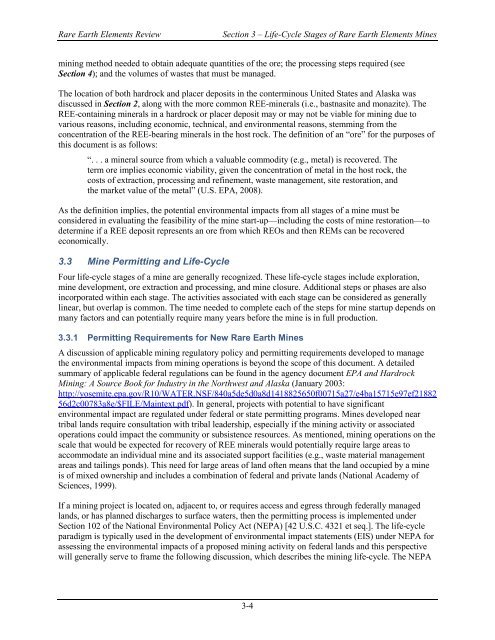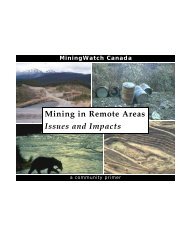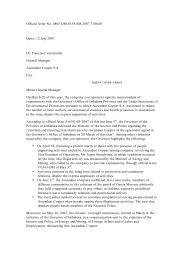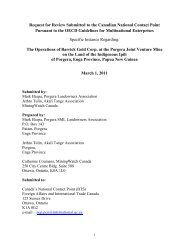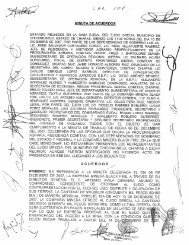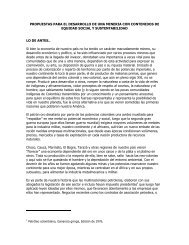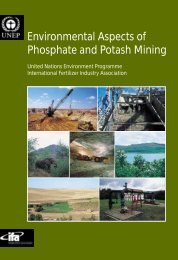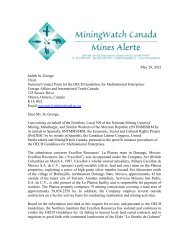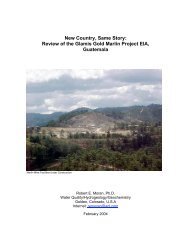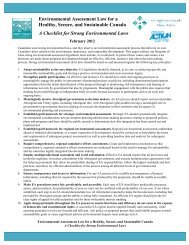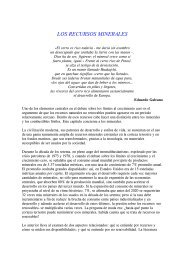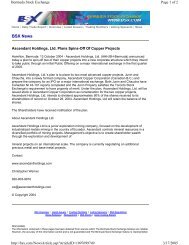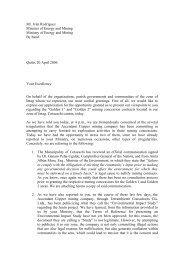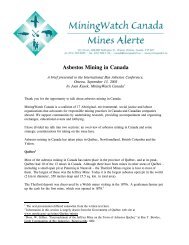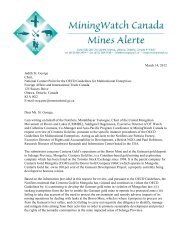Rare Earth Elements: A Review of Production, Processing ...
Rare Earth Elements: A Review of Production, Processing ...
Rare Earth Elements: A Review of Production, Processing ...
You also want an ePaper? Increase the reach of your titles
YUMPU automatically turns print PDFs into web optimized ePapers that Google loves.
<strong>Rare</strong> <strong>Earth</strong> <strong>Elements</strong> <strong>Review</strong><br />
Section 3 – Life-Cycle Stages <strong>of</strong> <strong>Rare</strong> <strong>Earth</strong> <strong>Elements</strong> Mines<br />
mining method needed to obtain adequate quantities <strong>of</strong> the ore; the processing steps required (see<br />
Section 4); and the volumes <strong>of</strong> wastes that must be managed.<br />
The location <strong>of</strong> both hardrock and placer deposits in the conterminous United States and Alaska was<br />
discussed in Section 2, along with the more common REE-minerals (i.e., bastnasite and monazite). The<br />
REE-containing minerals in a hardrock or placer deposit may or may not be viable for mining due to<br />
various reasons, including economic, technical, and environmental reasons, stemming from the<br />
concentration <strong>of</strong> the REE-bearing minerals in the host rock. The definition <strong>of</strong> an “ore” for the purposes <strong>of</strong><br />
this document is as follows:<br />
“. . . a mineral source from which a valuable commodity (e.g., metal) is recovered. The<br />
term ore implies economic viability, given the concentration <strong>of</strong> metal in the host rock, the<br />
costs <strong>of</strong> extraction, processing and refinement, waste management, site restoration, and<br />
the market value <strong>of</strong> the metal” (U.S. EPA, 2008).<br />
As the definition implies, the potential environmental impacts from all stages <strong>of</strong> a mine must be<br />
considered in evaluating the feasibility <strong>of</strong> the mine start-up—including the costs <strong>of</strong> mine restoration—to<br />
determine if a REE deposit represents an ore from which REOs and then REMs can be recovered<br />
economically.<br />
3.3 Mine Permitting and Life-Cycle<br />
Four life-cycle stages <strong>of</strong> a mine are generally recognized. These life-cycle stages include exploration,<br />
mine development, ore extraction and processing, and mine closure. Additional steps or phases are also<br />
incorporated within each stage. The activities associated with each stage can be considered as generally<br />
linear, but overlap is common. The time needed to complete each <strong>of</strong> the steps for mine startup depends on<br />
many factors and can potentially require many years before the mine is in full production.<br />
3.3.1 Permitting Requirements for New <strong>Rare</strong> <strong>Earth</strong> Mines<br />
A discussion <strong>of</strong> applicable mining regulatory policy and permitting requirements developed to manage<br />
the environmental impacts from mining operations is beyond the scope <strong>of</strong> this document. A detailed<br />
summary <strong>of</strong> applicable federal regulations can be found in the agency document EPA and Hardrock<br />
Mining: A Source Book for Industry in the Northwest and Alaska (January 2003:<br />
http://yosemite.epa.gov/R10/WATER.NSF/840a5de5d0a8d1418825650f00715a27/e4ba15715e97ef21882<br />
56d2c00783a8e/$FILE/Maintext.pdf). In general, projects with potential to have significant<br />
environmental impact are regulated under federal or state permitting programs. Mines developed near<br />
tribal lands require consultation with tribal leadership, especially if the mining activity or associated<br />
operations could impact the community or subsistence resources. As mentioned, mining operations on the<br />
scale that would be expected for recovery <strong>of</strong> REE minerals would potentially require large areas to<br />
accommodate an individual mine and its associated support facilities (e.g., waste material management<br />
areas and tailings ponds). This need for large areas <strong>of</strong> land <strong>of</strong>ten means that the land occupied by a mine<br />
is <strong>of</strong> mixed ownership and includes a combination <strong>of</strong> federal and private lands (National Academy <strong>of</strong><br />
Sciences, 1999).<br />
If a mining project is located on, adjacent to, or requires access and egress through federally managed<br />
lands, or has planned discharges to surface waters, then the permitting process is implemented under<br />
Section 102 <strong>of</strong> the National Environmental Policy Act (NEPA) [42 U.S.C. 4321 et seq.]. The life-cycle<br />
paradigm is typically used in the development <strong>of</strong> environmental impact statements (EIS) under NEPA for<br />
assessing the environmental impacts <strong>of</strong> a proposed mining activity on federal lands and this perspective<br />
will generally serve to frame the following discussion, which describes the mining life-cycle. The NEPA<br />
3-4


